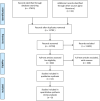A systematic review of the burden of hypertension, access to services and patient views of hypertension in humanitarian crisis settings
- PMID: 33168520
- PMCID: PMC7654140
- DOI: 10.1136/bmjgh-2020-002440
A systematic review of the burden of hypertension, access to services and patient views of hypertension in humanitarian crisis settings
Abstract
Introduction: Globally, a record number of people are affected by humanitarian crises caused by conflict and natural disasters. Many such populations live in settings where epidemiological transition is underway. Following the United Nations high level meeting on non-communicable diseases, the global commitment to Universal Health Coverage and needs expressed by humanitarian agencies, there is increasing effort to develop guidelines for the management of hypertension in humanitarian settings. The objective was to investigate the prevalence and incidence of hypertension in populations directly affected by humanitarian crises; the cascade of care in these populations and patient knowledge of and attitude to hypertension.
Methods: A literature search was carried out in five databases. Grey literature was searched. The population of interest was adult, non-pregnant, civilians living in any country who were directly exposed to a crisis since 1999. Eligibility assessment, data extraction and quality appraisal were carried out in duplicate.
Results: Sixty-one studies were included in the narrative synthesis. They reported on a range of crises including the wars in Syria and Iraq, the Great East Japan Earthquake, Hurricane Katrina and Palestinian refugees. There were few studies from Africa or Asia (excluding Japan). The studies predominantly assessed prevalence of hypertension. This varied with geography and age of the population. Access to care, patient understanding and patient views on hypertension were poorly examined. Most of the studies had a high risk of bias due to methods used in the diagnosis of hypertension and in the selection of study populations.
Conclusion: Hypertension is seen in a range of humanitarian settings and the burden can be considerable. Further studies are needed to accurately estimate prevalence of hypertension in crisis-affected populations throughout the world. An appreciation of patient knowledge and understanding of hypertension as well as the cascade of care would be invaluable in informing service provision.
Keywords: epidemiology; health policy; hypertension; public health; systematic review.
© Author(s) (or their employer(s)) 2020. Re-use permitted under CC BY. Published by BMJ.
Conflict of interest statement
Competing interests: None declared.
Figures



Similar articles
-
A systematic review of the burden of, access to services for and perceptions of patients with overweight and obesity, in humanitarian crisis settings.PLoS One. 2023 Apr 24;18(4):e0282823. doi: 10.1371/journal.pone.0282823. eCollection 2023. PLoS One. 2023. PMID: 37093795 Free PMC article.
-
Chronic NCD care in crises: A qualitative study of global experts' perspectives on models of care for hypertension and diabetes in humanitarian settings.J Migr Health. 2022 Mar 24;5:100094. doi: 10.1016/j.jmh.2022.100094. eCollection 2022. J Migr Health. 2022. PMID: 35434681 Free PMC article.
-
A Scoping Review of Factors Associated with HIV Acquisition in the Context of Humanitarian Crises.AIDS Behav. 2024 Dec;28(12):4224-4273. doi: 10.1007/s10461-024-04504-x. Epub 2024 Sep 18. AIDS Behav. 2024. PMID: 39292318
-
The burden of diabetes and use of diabetes care in humanitarian crises in low-income and middle-income countries.Lancet Diabetes Endocrinol. 2019 Aug;7(8):638-647. doi: 10.1016/S2213-8587(19)30082-8. Epub 2019 Mar 14. Lancet Diabetes Endocrinol. 2019. PMID: 30878268 Review.
-
Meeting AT needs in humanitarian crises: The current state of provision.Assist Technol. 2021 Dec 1;33(sup1):3-16. doi: 10.1080/10400435.2021.1934612. Assist Technol. 2021. PMID: 34951828
Cited by
-
Managing hypertension in a Rohingya refugee camp: a brief report.BMJ Open Qual. 2022 Dec;11(4):e001846. doi: 10.1136/bmjoq-2022-001846. BMJ Open Qual. 2022. PMID: 36588321 Free PMC article.
-
Addressing global disparities in blood pressure control: perspectives of the International Society of Hypertension.Cardiovasc Res. 2023 Mar 31;119(2):381-409. doi: 10.1093/cvr/cvac130. Cardiovasc Res. 2023. PMID: 36219457 Free PMC article.
-
Mental and behavioral health problems among displaced Myanmar adults exhibiting suboptimal adherence to chronic disease medication treatment in Thailand.J Migr Health. 2024 Oct 30;10:100279. doi: 10.1016/j.jmh.2024.100279. eCollection 2024. J Migr Health. 2024. PMID: 39624506 Free PMC article.
-
Understanding the health needs of internally displaced persons: A scoping review.J Migr Health. 2021 Oct 29;4:100071. doi: 10.1016/j.jmh.2021.100071. eCollection 2021. J Migr Health. 2021. PMID: 34820657 Free PMC article.
-
Healthcare Access and Outcomes for Refugee Women in Transit: A Scoping Review of Facilitators and Barriers in South and Southeast Asia.J Immigr Minor Health. 2025 Jun 30. doi: 10.1007/s10903-025-01722-w. Online ahead of print. J Immigr Minor Health. 2025. PMID: 40587049 Review.
References
-
- World Health Organization World health statistics 2016: monitoring health for the SDGs sustainable development goals. World Health Organization, 2016.
-
- Proulx M. What is a humanitarian emergency? Available: https://www.humanitariancoalition.ca/info-portal/factsheets/what-is-a-hu... [Accessed 26 Apr 2020].
-
- UNHCR Global trends - forced displacement in 2018. Available: https://www.unhcr.org/5d08d7ee7.pdf [Accessed 5 Aug 2019].
-
- IHME GBD compare [Internet]. Available: http://vizhub.healthdata.org/gbd-compare [Accessed 5 Aug 2019].
Publication types
MeSH terms
LinkOut - more resources
Full Text Sources
Medical
